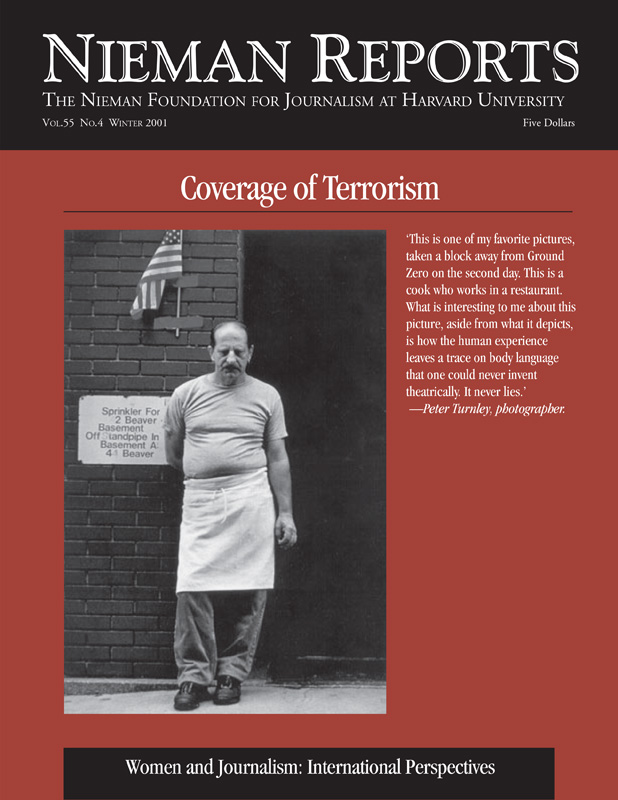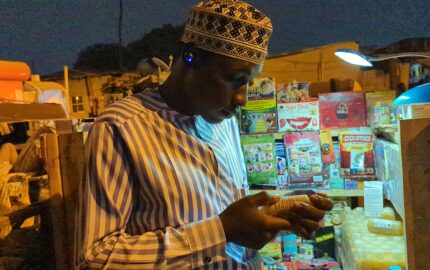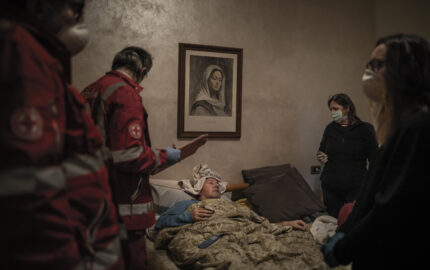
In two separate investigations—separated by five years—the Global Media Monitoring Project (GMMP) provided just this kind of information. “Women’s Participation in the News,” an examination of the day’s news on January 18, 1995 in 71 countries, revealed that women were the subject of news reports on radio, television and newspapers just 17 percent of the time. [That left men’s visibility at 83 percent.] Five years later, after a period spanning a myriad of women’s campaigns, including the massive World Conference on Women in Beijing and the post-Beijing activities, a more indepth Global Media Monitoring Project took place on February 1, 2000 in 70 countries. The main findings, published in “Who Makes the News?” had hardly changed. Women in the world’s media that day were found to be just 18 percent of the news subjects. These findings emerged at a time when women made up 41 percent of announcers and reporters of the news.
GMMP 2000 was the work of the World Association for Christian Communication (WACC) Women and Media Programme. For more than a decade, the WACC Women’s Programme has been organizing and supporting workshops and conferences, including the international conference on “Women Empowering Communication,” held in Bangkok and attended by 430 media and gender activists in 1994. One of the main recommendations of the Bangkok Declaration was the undertaking of a global media monitoring study. The 1995 effort, coordinated by MediaWatch Canada, and the 2000 effort, organized by WACC, are considered the most extensive analysis of women’s presence and participation in the world’s media.
WACC was determined that the broad aims of the GMMP 2000 would be to strengthen solidarity among women in the media, media literacy, and advocacy on media and gender issues. The work in 1995 had already helped to demystify this kind of research by providing a worldwide network of monitors with the opportunity and tools to assess gender representation in the media. By 2000, we were able to see not only what changes had taken place after five years and research new questions but to extend the use of our findings. We could offer various monitoring groups contextual analysis, including results from their own country and region, which they could use in their education and advocacy work.
Employment Practices and the Presence of Women Journalists in the News Media
During the last 40 years there have been immense changes in women’s participation in the news media. In the 1960’s and 1970’s, it was a rare event to see women anchoring television newscasts, yet today women make up a slight majority of television news announcers (56 percent), according to data from GMMP 2000. There have been less dramatic increases in women’s participation as reporters—a large majority (69 percent) of reporters are still male.
The increasing presence of women in television news media is undoubtedly an important advance, yet even a cursory look at employment practices in the news media reveals a less rosy picture. At WACC’s regional conferences on Gender and Communication Policy—held in Asia, Africa, the Middle East, Latin America, the Caribbean, and the Pacific between 1997-2000, many women journalists revealed that their appearance rather than their intellectual abilities or experience is frequently used as part of the criteria for their selection. This evidence is supported by GMMP 2000, which showed that although there are more women news presenters on television, they tend to disappear from the screen at an earlier age than their male colleagues do. From Asia to Africa and the Middle East, participants at the WACC conferences also confirmed that while women are more present in the newsroom, they continue to be victims of harassment and discrimination.
News Reporting and the Gender Division of Labor
What news do men and women report? Research has shown that there is a clear gender division of labor in news reporting, and this finding was confirmed by GMMP 2000. Women journalists are often confined to reporting local news rather than national or foreign news and “soft” topics such as entertainment or health more often than politics or crime. This gender segregation of labor, in addition to the relative values attached to “hard” and “soft” news, mean that while women now comprise a greater proportion of news reporters than before, they are not enjoying equality with their male counterparts.
Women Journalists and Gender Sensitivity
Whether an increase in the number of women journalists will lead to improved coverage of women and women’s issues in the media is highly contested. Recent research has done little to throw light on the matter. Although some argue that a critical mass of women working in the media can and will make an imprint on media content, others have highlighted the need to consider the more dominant impact of media ownership and the prevailing culture within the media industry.
RELATED ARTICLE
"Reporting on Gender in Journalism"
- Margaret GallagherThe difficulties associated with women’s representation in the media cannot simply be reduced by notching up a few percentage points in the share of women’s time on air or in print. As Margaret Gallagher observed in “Gender Setting: New Agendas for Media Monitoring and Advocacy” (London, Zed Books 2001), “What is at stake is not just the number of women who appear in the media, but the weight of their voices.”
Evidence has, to date, been mixed. In “Who Makes the News?” the following information was gathered:
- In stories by female reporters, 24 percent of news subjects are women, whereas in stories by male reporters, only 18 percent of news subjects are women.
- In female reporters’ coverage of “hard” news, 15 percent of news subjects are women, compared to 12 percent in coverage by male reporters.
- In “soft” news coverage by female reporters, 32 percent of news subjects are women, yet by male reporters, 27 percent are women.
Both “hard” and “soft” news stories by female reporters clearly do have more female news subjects than do those by male reporters, yet the portrayal of women in the media has not improved dramatically. Perhaps, then, the crucial question is, as Gallagher states, “not who is telling the story but how the story is told.”
The Presence and Portrayal of Women in the News Media
One of the most startling results of GMMP 2000 was the discovery that women are a central focus in only 10 percent of stories. But even these stories are rarely inspired by a concern with women’s relationships to or views about political, economic or social matters. Instead, many of these stories focus on women in stereotypical roles.
Quite common was the portrayal of women as victims, particularly of crime. While victims are, in general, common currency in news programs, women were found nearly three times more likely to appear as victims than men. Other stories from GMMP 2000 showed women’s success in beauty contests or in weight reducing competitions. A few highlighted the more serious achievements of women, and a sprinkling actually addressed questions of women’s rights or status in the political or social world.
As Gallagher shows in her analysis of the findings of GMMP 2000, while these sorts of stories do give time and space to women in the news, the content rarely advances the featured women’s concerns or the interests of women overall. An extreme example comes from Turkey where only three percent of stories in the media focused on women. One of those was a television item about research into the link between heart attacks and snoring in women—a serious issue—yet the video footage used to illustrate the report showed women in bikinis posing on a beach.
Also missing from news stories that focus on women are the voices of the women concerned. Though not totally silent, their voices are heard only in the margins of the news agenda, rather than at its core. Frequently news accounts miss the opportunity to broaden the scope of their stories by including women’s perspectives, even in cases where those views seemed essential to the story. One of the most striking examples in GMMP 2000 came from a Sudanese newspaper story about the problems faced by young women when they move away from home to study in another town. The article interviewed a male teacher and a male student, but did not include any words or views from a female. As Gallagher shows, this tendency to talk about rather than to women illustrates not only the very real absence of women’s voices, but the profound lack of attention paid by the news media to the telling of women’s stories generally.
Our monitoring efforts allow us to scrutinize what and how the news media are doing in regard to news coverage of women. But they also create a tool for action. Networks of women are energized by the organization and work of monitoring and once the findings emerge, they are empowered to promote change by the knowledge they have acquired. While we often hear that news is simply a reflection of what is happening, this closeup look, across borders and time zones, reminds women that reflections of their lives and their issues are still absent, despite their increasing presence in newsrooms. GMMP 2000 has provided the means for us to answer some of our questions, but what it does is raise so many more to which answers must be found.
Teresita Hermano is the director for services and the Women’s Programme at the World Association for Christian Communication. Anna Turley is the Women and Media Programme officer. Additional information from these reports can be found at www.wacc.org.uk.


